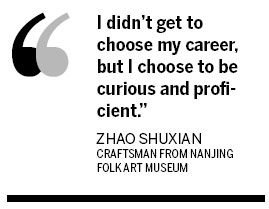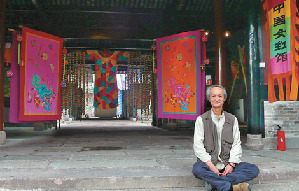Always in bloom
Updated: 2013-08-20 13:33
By Xu Junqian (China Daily)
|
|||||||||||
 |
|
Actress Yao Xingtong attends the 65th Cannes Film Festival in May 2012, in the white gown featuring more than 1,000 featherlike velvet petals handmade by Zhao Shuxian. China Photo Press |
Counting the pile of parcel receipts with which his flowers would be sent to all over China, Zhao says most people are buying his works, ranging from 25 yuan a lily to 2,000 yuan for a phoenix-like crown, for big occasions like weddings and festivals to accessorize their Chinese-style costumes.
"In fashion, they say less is more. And here, the old is new," he jokes.
Zhao, who speaks with a heavy Nanjing accent, is one of the few, if not the only, velvet flower craftsmen in China. In 2008, the craft failed to be chosen as a national intangible cultural heritage because there is only one craftsman who was found to know how to make them.
The history of the velvet flower can be dated back to the Tang Dynasty (AD 618-907), when it was first presented to emperors as a tribute.
Velvet flowers soon replaced fresh flowers in the royal palace as they are neither seasonal nor do they ever fade, symbolizing everlasting youth which was so cherished by women of the time. Its name, ronghua, is also a homophone with the Chinese word for prosperity, considered auspicious by the ruling class.
Before the Ming and Qing dynasties (1368-1911), the flowers were a luxury only available to the royals, but they later became a popular accessory for almost every woman, especially in Nanjing and neighboring cities, where the textile industry was strong and the cost of a velvet flower, which was mainly made from leftover silks, was very low. The skeleton of the flower is usually copper, with the flowers made for royals using silver wire.
For more China Face, here| Crafting a town | Walk the talk |
Related Stories
Flower grannies keep a fragrant tradition alive 2013-08-13 14:04
Crafting a town 2013-08-08 11:41
Walk the talk 2013-08-08 10:36
Pottery craft a dying art 2013-08-07 15:18
Inheriting traditional tin pot technique 2013-08-01 13:50
Stitches in time 2013-04-07 14:24
Today's Top News
More New Zealand dairy products banned
Snowden reporter to publish UK secrets
China, Kenya agree to bolster relations
Typhoon wreaks havoc in the south
Western program engine for growth
Egypt's Mubarak may be freed
Bank's position to stay 'prudent'
ROK-US drill goes ahead as tensions ease
Hot Topics
Lunar probe , China growth forecasts, Emission rules get tougher, China seen through 'colored lens', International board,
Editor's Picks

|

|

|

|

|

|








